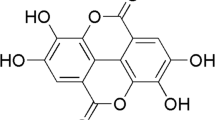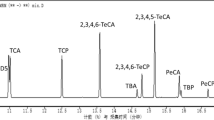Abstract
A method for determination of ochratoxin A (OTA) in wines using a new-solid phase extraction clean-up procedure followed with ultra performance liquid chromatography (UHPLC)-Orbitrap MS based on two scan events (full-scan Fourier transform mass spectrometer [FTMS] and higher energy-induced collision dissociation[HCD] data-dependent MS/MS) in positive ionization mode has been developed. The limit of detection (LOD) was estimated at 0.46 μg l−1 for white wine, 0.53 and 0.54 μg l−1 for rosé and red wines, respectively. The limit of quantification (LOQ) was estimated at 1.57 μg l−1 in white wine, 1.77 and 1.81 μg l−1 in rosé and red wines. Recovery experiments were carried out with spiked samples at three concentration levels (2, 5 and 10 μg l−1). The OTA recoveries in spiked white wine samples varied from 69.6 % to 99.8 %, while the recoveries for rosé and red wine samples were in the range of 63.0–110.2 % and 63.6–103.2 %, respectively. Finally, based on the results, it is concluded that the combination of C18 cartridge with conventional particle packed columns and UHPLC LTQ-Orbitrap XL is an appropriate procedure for OTA analysis in wines.




Similar content being viewed by others
References
Alvito PC, Sizoo EA, Almeida CMM, van Egmond JP (2010) Occurrence of aflatoxins and ochratoxin A in baby foods in Portugal. Food Anal Methods 3:22
AOAC (1995) Official Methods of Analysis of AOAC International. 16th edition. Arlington, VA, USA, AOAC International. 973.37: 37
Aresta A, Vatinno R, Palmisano F, Zambonin CG (2006) Determination of ochratoxin A in wine at sub ng/mL levels by solid-phase microextraction coupled to liquid chromatography with fluorescence detection. J Chromatogr A 1115:196
Blesa J, Soriano JM, Moltó JC, Mañes J (2004) Concentration of ochratoxin A in wines from supermarkets and stores of Valencian Community (Spain). J Chromatogr A 1054:397
Brera C, Soriano JM, Debegnach F, Miraglia M (2005) Exposure assessment to ochratoxin A from the consumption of Italian and Hungarian wines. Microchem J 79:109
European Union (2009) Method validation and quality control procedures for pesticide residues analysis in food and feed. Document No. SANCO/10684/2009. 18
European Union (2002) Implementing Council Directive 96/23/EC concerning the performance of analytical methods and the interpretation of results. Commission Decision 657/2002/EC. Off J Eur Union L 221:8
European Union (2006) Setting maximum levels for certain contaminants in foodstuffs. Commission Regulation 1881/2006/EC. Off J Eur Union L 364:5
Folloni S, Bellocchi G, Kagkli DM, Pastor-Benito S, Aguilera M, Mazzeo A, Querci M, Van den Eede G, Ermolli M (2011) Development of an ELISA reverse-based assay to assess the presence of mycotoxins in cereal flour. Food Anal Methods 4:221
Herebian D, Zühlke S, Lamshöft M, Spiteller M (2009) Multi-mycotoxin analysis in complex biological matrices using LC-ESI/MS: Experimental study using triple stage quadrupole and LTQ-Orbitrap. J Sep Sci 32:939
Hernández MJ, García-Moreno MV, Durán E, Guillén D, Barroso CG (2006) Validation of two analytical methods for the determination of ochratoxin A by reversed-phased high-performance liquid chromatography coupled to fluorescence detection in musts and sweet wines from Andalusia. Anal Chim Acta 566:117
Hussein HS, Brasel JM (2001) Toxicity, metabolism, and impact of mycotoxins on humans and animals. Toxicology 167:101
JECFA (2001) Safety Evaluation of Certain Mycotoxins in Food: Fifty-sixth report of the Joint FAO/WHO Expert Committee on Food Additives. WHO technical report series no. 906. World Health Organization, Geneva
Jornet D, Busto O, Guasch J (2000) Solid-phase extraction applied to the determination of ochratoxin A in wines by reversed-phase high-performance liquid chromatography. J Chromatogr A 882:29
Juan C, Lino CM, Pena A, Moltó JC, Mañes J, Silveira I (2007) Determination of ochratoxin A in maize bread samples by LC with fluorescence detection. Talanta 73:246
Kokkonen MK, Jestoi MN (2009) A multi-compound LC-MS/MS method for the screening of mycotoxins in grains. Food Anal Methods 2:128
Lee HB, Magan N (2000) Impact of environment and interspecific interactions between spoilage fungi and Aspergillus ochraceus on growth and ochratoxin production in maize grain. Int J Food Microbiol 61:11
Leitner A, Zöllner P, Paolillo A, Stroka J, Papadopoulou-Bouraoui A, Jaborek S, Anklam E, Lindner W (2002) Comparison of methods for the determination of ochratoxin A in wine. Anal Chim Acta 453:33
Li J, Xie H, Yang B, Dong X, Feng L, Chen F, Jiang Y (2010) A comparative identification of ochratoxin A in longan fruit pulp by high performance liquid chromatography-fluorescence detection and electron spray ionization-mass spectrometry. Molecules 15:680
Liu X, Yang JL, Li JH, Li XL, Li J, Lu XY, Shen JZ, Wang YW, Zhang ZH (2011) Analysis of water-soluble azo dyes in soft drinks by high resolution UPLC–MS. Food Addit Contam A 28:1315
Maier NM, Buttinger G, Welhartizki S, Gavioli E, Lindner W (2004) Molecularly imprinted polymer-assisted sample clean-up of ochratoxin A from red wine: merits and limitations. J Chromatogr B 804:103
Markaki P, Delpont-Binet C, Grosso F, Dragacci S (2001) Determination of ochratoxin A in red wine and vinegar by immunoaffinity high-pressure liquid chromatography. J Food Prot 64:533
Nielen MW, van Engelen MC, Zuiderent R, Ramaker R (2007) Screening and confirmation criteria for hormone residue analysis using liquid chromatography accurate mass time-of-flight, fourier transform ion cyclotron resonance and orbitrap mass spectrometry techniques. Anal Chim Acta 586:122
Pitt JJ (2009) Principles and applications of liquid chromatography-mass spectrometry in clinical biochemistry. Clin Biochem Rev 30:19
Pohland AE, Schuller PL, Steyn PS, Van Egmond HP (1982) Physicochemical data for some selected mycotoxins. Pure Appl Chem 54:2219
Ramos AJ, Labernia N, Marín S, Sanchis V, Magan N (1998) Effect of water activity and temperature on growth and ochratoxin production by three strains of Aspergillus ochraceus on a barley extract medium and on barley grains. Int J Food Microbiol 44:133
Serra R, Mendonça C, Abrunhosa L, Pietri A, Venâncio A (2004) Determination of ochratoxin A in wine grapes: comparison of extraction procedures and method validation. Anal Chim Acta 513:41
Skrabáková Z, O'Halloran J, van Pelt FNAM, James KJ (2010) Food contaminant analysis at ultra-high mass resolution: application of hybrid linear ion trap-orbitrap mass spectrometry for the determination of the polyether toxins, azaspiracids, in shellfish. Rapid Commun Mass Spectrom 24:2966
Soleas GJ, Yan J, Goldberg DM (2001) Assay of ochratoxin A in wine and beer by high-pressure liquid chromatography photodiode array and gas chromatography mass selective detection. J Agric Food Chem 49:2733
Studer-Rohr I, Dietrich DR, Schlatter J, Schlatter C (1995) The occurrence of ochratoxin A in coffee. Food Chem Toxicol 33:341
van der Heeft E, Bolck YJC, Beumer B, Nijrolder AWJM, Stolker AAM, Nielen MWF (2009) Full-scan accurate mass selectivity of ultra-performance liquid chromatography combined with time-of-flight and orbitrap mass spectrometry in hormone and veterinary drug residue analysis. J Am Soc Mass Spectrom 20:451
Var I, Kabak B (2007) Occurrence of ochratoxin A in Turkish wines. Microchem J 86:241
Visconti A, Pascale M, Centonze G (1999) Determination of ochratoxin A in wine by means of immunoaffinity column clean-up and high-performance liquid chromatography. J Chromatogr A 864:89
Zain ME (2011) Impact of mycotoxins on humans and animals. J Saudi Chem Soc 15:129
Zimmerli B, Dick R (1996) Ochratoxin A in table wine and grape-juice: Occurrence and risk assessment. Food Addit Contam 13:655
Zöllner P, Leitner A, Lubda D, Cabrera K, Lidner W (2000) Application of a chromolith speedROD RP-18e HPLC column: Determination of ochratoxin A in different wines by high-performance liquid chromatography-tandem mass spectrometry. Chromatographia 52:818
Acknowledgements
This work was funded by Science and Technology Planning Project of General Administration of Quality Supervision, Inspection and Quarantine (AQSIQ) of P.R. China (2011IK190, 2012IK145); and AQSIQ Industrial Public Service Scientific Research Project of P. R. China (201210029).
Author information
Authors and Affiliations
Corresponding author
Rights and permissions
About this article
Cite this article
Li, J., Liu, X., Han, S. et al. Analysis of Ochratoxin A in Wine by High-Resolution UHPLC-MS. Food Anal. Methods 5, 1506–1513 (2012). https://doi.org/10.1007/s12161-012-9403-9
Received:
Accepted:
Published:
Issue Date:
DOI: https://doi.org/10.1007/s12161-012-9403-9




